第7章氨基酸代谢ppt课件
- 格式:ppt
- 大小:2.71 MB
- 文档页数:60


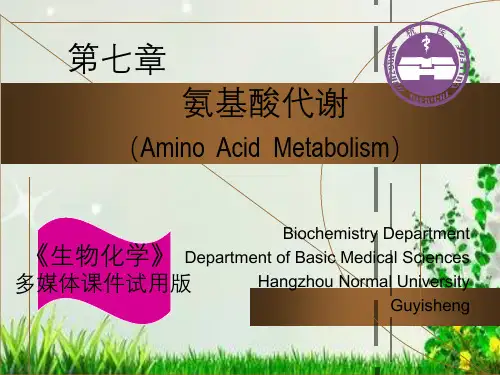


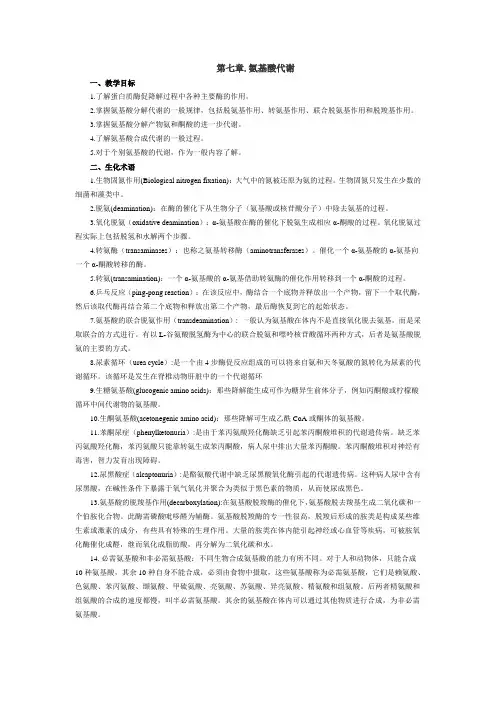
第七章.氨基酸代谢一、教学目标1.了解蛋白质酶促降解过程中各种主要酶的作用。
2.掌握氨基酸分解代谢的一般规律,包括脱氨基作用、转氨基作用、联合脱氨基作用和脱羧基作用。
3.掌握氨基酸分解产物氨和酮酸的进一步代谢。
4.了解氨基酸合成代谢的一般过程。
5.对于个别氨基酸的代谢,作为一般内容了解。
二、生化术语1.生物固氮作用(Biological nitrogen fixation):大气中的氮被还原为氨的过程。
生物固氮只发生在少数的细菌和藻类中。
2.脱氨(deamination):在酶的催化下从生物分子(氨基酸或核苷酸分子)中除去氨基的过程。
3.氧化脱氨(oxidative deamination):α-氨基酸在酶的催化下脱氨生成相应α-酮酸的过程。
氧化脱氨过程实际上包括脱氢和水解两个步骤。
4.转氨酶(transaminases):也称之氨基转移酶(aminotransferases)。
催化一个α-氨基酸的α-氨基向一个α-酮酸转移的酶。
5.转氨(transamination):一个α-氨基酸的α-氨基借助转氨酶的催化作用转移到一个α-酮酸的过程。
6.乒乓反应(ping-pong reaction):在该反应中,酶结合一个底物并释放出一个产物,留下一个取代酶,然后该取代酶再结合第二个底物和释放出第二个产物,最后酶恢复到它的起始状态。
7.氨基酸的联合脱氨作用(transdeamination): 一般认为氨基酸在体内不是直接氧化脱去氨基,而是采取联合的方式进行。
有以L-谷氨酸脱氢酶为中心的联合脱氨和嘌呤核苷酸循环两种方式,后者是氨基酸脱氨的主要的方式。
8.尿素循环(urea cycle):是一个由4步酶促反应组成的可以将来自氨和天冬氨酸的氮转化为尿素的代谢循环。
该循环是发生在脊椎动物肝脏中的一个代谢循环9.生糖氨基酸(glucogenic amino acids):那些降解能生成可作为糖异生前体分子,例如丙酮酸或柠檬酸循环中间代谢物的氨基酸。
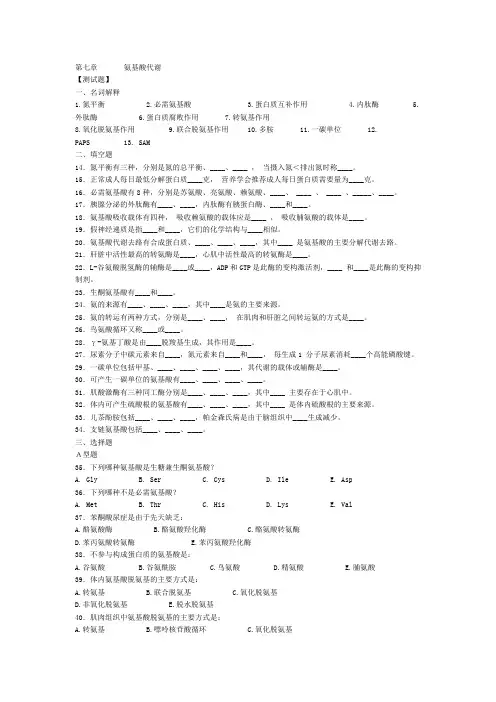
第七章氨基酸代谢【测试题】一、名词解释1.氮平衡2.必需氨基酸3.蛋白质互补作用4.内肽酶5.外肽酶6.蛋白质腐败作用7.转氨基作用8.氧化脱氨基作用 9.联合脱氨基作用 10.多胺 11.一碳单位 12.PAPS 13. SAM二、填空题14.氮平衡有三种,分别是氮的总平衡、____、____ ,当摄入氮<排出氮时称____。
15.正常成人每日最低分解蛋白质____克,营养学会推荐成人每日蛋白质需要量为____克。
16.必需氨基酸有8种,分别是苏氨酸、亮氨酸、赖氨酸、____、 ____ 、 ____ 、_____、____。
17.胰腺分泌的外肽酶有____、____,内肽酶有胰蛋白酶、____和____。
18.氨基酸吸收载体有四种,吸收赖氨酸的载体应是____ ,吸收脯氨酸的载体是____。
19.假神经递质是指____和____,它们的化学结构与____相似。
20.氨基酸代谢去路有合成蛋白质、____、____、____,其中____ 是氨基酸的主要分解代谢去路。
21.肝脏中活性最高的转氨酶是____,心肌中活性最高的转氨酶是____。
22.L-谷氨酸脱氢酶的辅酶是____或____,ADP和GTP是此酶的变构激活剂,____ 和____是此酶的变构抑制剂。
23.生酮氨基酸有____和____。
24.氨的来源有____、____、____,其中____是氨的主要来源。
25.氨的转运有两种方式,分别是____、____,在肌肉和肝脏之间转运氨的方式是____。
26.鸟氨酸循环又称____或____。
28.γ-氨基丁酸是由____脱羧基生成,其作用是____。
27.尿素分子中碳元素来自____,氮元素来自____和____,每生成1 分子尿素消耗____个高能磷酸键。
29.一碳单位包括甲基、____、____、____、____,其代谢的载体或辅酶是____。
30.可产生一碳单位的氨基酸有____、____、____、____。
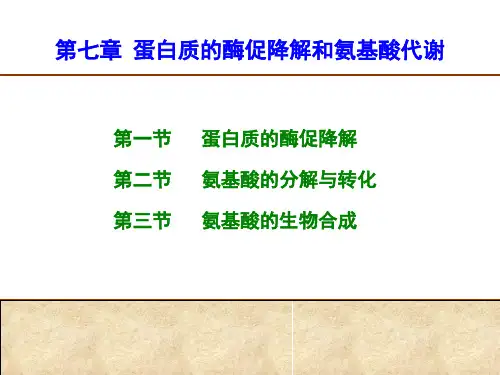
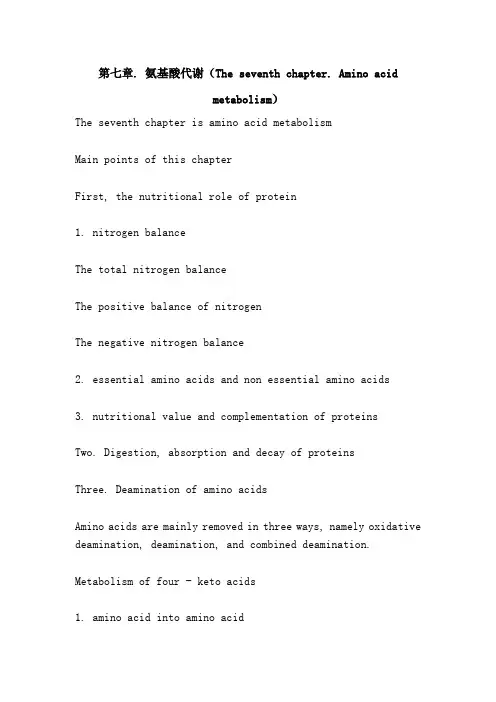
第七章. 氨基酸代谢(The seventh chapter. Amino acidmetabolism)The seventh chapter is amino acid metabolismMain points of this chapterFirst, the nutritional role of protein1. nitrogen balanceThe total nitrogen balanceThe positive balance of nitrogenThe negative nitrogen balance2. essential amino acids and non essential amino acids3. nutritional value and complementation of proteinsTwo. Digestion, absorption and decay of proteinsThree. Deamination of amino acidsAmino acids are mainly removed in three ways, namely oxidative deamination, deamination, and combined deamination.Metabolism of four - keto acids1. amino acid into amino acid2. change to sugar or fat3. oxidation energy supplyFive. Metabolism of ammonia1. sources and routes of blood ammonia:The source of blood ammonia: by intestinal absorption; the amino acid deamination of the amino acid amide; hydrolysis; decomposition of the other nitrogen compounds.The blood ammonia way: in the liver into the synthesis of urea; amino acids; the synthesis of other nitrogenous compounds; the synthesis of asparagine and glutamine; the direct discharge.2. ammonia transport in the bloodThe alanine glucose cycleThe role of glutamine transport of ammonia3. ornithine cycle and urea synthesisThe characteristics of urea synthesis: synthesis mainly in mitochondria and cytosol of the liver in the synthesis of urea molecules; consume four ATP molecules; the argininosuccinate synthase is a key enzyme in the synthesis of urea; the two nitrogen atoms of the urea molecule, one from the NH3, a source in ASP amino acid.Six, the decarboxylation of amino acidsCatalyzed by amino acid decarboxylase, coenzyme pyridoxal phosphate, the product was CO2 and amine. Understanding the physiological roles of several important amines.Seven, the concept, source and physiological function of one carbon unitEight, S- methionine cycleNine. Metabolism of aromatic amino acidsThe major metabolic processes in nerve tissue cells are phenylalanine, tyrosine, DOPA, dopamine, norepinephrine, norepinephrine, and epinephrine. Dopamine, norepinephrine, and epinephrine are collectively called catecholamines. In melanoma cells, Duobake into melanoma. A genetic defect in phenylalanine hydroxylase causes phenylketonuria, a genetic defect in tyrosinase that causes albinism.ExercisesFirst, the multiple-choice question1. the following are the essential amino acids:A. glutamic acidB. phenylalanineC. alanineD. glutamineE. cysteine2. which of the following substances does not belong to a carbon unit?A.CH3B.CH2C.CH=D.CH=NHE.COOH3. the carrier of a carbon unit in vivo isA. folic acid,B., leucovorinC. dihydrofolateD. pantothenic acidE. biotin4. which of the following is not only the ketogenic amino sugar amino acids?A. leucineB. tyrosineC. isoleucineD. threonineE. glycine5. amino acids that can be converted into taurine are:A. leucineB. aspartateC. valineD. glycineE. cysteine6. the following amino acids that are not involved in protein biosynthesis areA. glycine,B. ornithineC. proline,D. arginineE. valine7. which of the following amino acids can produce vasodilators?A.Tryptophan, B., prolineC. glutamic acidD. histidineE. hydroxyproline8. which of the following stages of urea synthesis occurs in mitochondria?A. produces citrulline,B. arginine hydrolysisC. produces arginine,D., to produce arginine instead ofsuccinic acidE. or more is wrongWhat kind of substance metabolism does 9.PAPS mainly come from?A. methionineB. taurineC. cysteineD. homocysteineE. or more is wrong10. which of the following two kinds of nitrogen does urea come from?A. ornithine and methotrexate phosphateB. aspartic acid and amino formyl phosphateC. - amino - and - amino groups of ornithineD. - amino acids and arginine - amino groups of citrullineE. ornithine - amino and glycine11., the most important metabolic pathway of ammonia in adults isA. forms the nonessential amino acidB., forming the essential amino acidC., forming NH4 +, which is excreted with urineD. forms ureaE., forming purine and pyrimidine nucleotides12. the main cause of elevated blood ammonia isA., excessive intake of protein,B., liver dysfunctionC. soap water (alkaline) enema, intestinal absorption of ammonia increasedD. renal dysfunction is not more thanE.13. which amino acids are produced by the conversion of catecholamines?A. tryptophan,B. glutamic acid,C. aspartate,D. tyrosine,E. lysineThe important role of 14.S- in methionine isA. supplementation methionine,B. synthesis, vitaminC., methylD. produces adenine nucleosideE.Homocysteine synthesisIn the 15. brain, - aminobutyric acid is produced by which of the following metabolites?A. aspartic acid glutamic acidB.C. oxoglutarateD. oxaloacetic acid,E. malic acid16. the ammonia produced in the kidneys is mainly derived from ammoniaCombined deamination of A. amino acidsHydrolysis of B. glutamineHydrolysis of C. ureaNon oxidative deamination of D. amino acidsOxidation of E. amines17. the major component of non protein nitrogen in the blood isA. urea,B., uric acid,C., creatine,D. polypeptide,E. amino acid18. can the free ammonia be produced by the continuous action of alanine and alpha pyruvate, alanine aminotransferase, and which of the following enzymes?A. B. C. aspartate aminotransferase enzyme glutamate dehydrogenaseD. glutamine synthetase,E., glutaric dehydrogenase19. in the presence of ornithine and amino acyl phosphate, the synthesis of urea also needs to be addedA. arginine,B.HCO3,C., citrulline,D., aspartic acid,E. are not above20. urea cycleThe A. needs to be supplied by the CTPB. aspartic acid contains carbon moieties that are incorporated into arginineC. arginine is a direct precursor of citrullineD. needs ornithineE. is a direct product of oxaloacetate argininosuccinate.The main route of ammonia in the brain is 21.A. synthesis ureaB. diffusion into bloodC. synthesis glutamineD. synthesis of amino acidsE. synthesis of purine22. which of the following compounds cannot be synthesized from tyrosine?A. thyroxine,B., epinephrine,C.Dopamine, D., phenylalanine, E. melanin23. the main means of deamination of amino acids in muscle isCombined deamination of A.B.L- oxidative deamination of glutamic acidC. ammonia transfer actionD. ornithine cycleE. purine nucleotide cycleWhich of the following 24. kinds of amino acids after transamination can generate oxaloacetateA. glutamic acid,B., alanine,C., threonine,D., aspartate,E., proline25. which of the following substances requires the synthesis of aspartic acid?A. porphyrinB. steroidsC. sphingolipidD. pyrimidineE. coenzyme AWhich vitamin does the coenzyme of 26. transaminase contain?A.Vit.B1,B.Vit.B12,C.Vit.C,D.Vit.B6,E.Vit.D27. which of the following substances is the form of ammonia storage and transportation in the body?A. glutamic acid,B., tyrosine,C., glutamine,D., glutathione,E., asparagine28. which of the following substances is the supplier of sulfate radicals in the body?A.ATP D.FAD E.GMPB.NADPC.PAPS29. albinism is due to deficiencyA. tryptophan hydroxylase,B. tyrosinase,C. phenylalanine hydroxylaseD. proline hydroxylase is no more thanE.30. amino acids that can be converted directly to - glutaric acidA. ASP,B., alanine,C., glutamic acid,D., glutamine,E., asparagine31. amino acids that can be converted to acetyl CoA areA. arginineB.Leucine, C., methionine, D., threonine, E., serine32. the enzyme that requires N- acetyl glutamate as an activator in the ornithine cycle isA. formyl phosphate synthetaseB. glutamyl transferaseC. arginine synthetaseD. arginine synthaseE. arginine lyase33. the vitamins necessary for the production of methionine by homocysteine and N5- areA. B. C. D. folic acid dihydrofolate tetrahydrofolate E.N5- methyltetrahydrofolic acid vitamin B1234. what is the lack of enzymes in the liver of people with phenylketonuria?A. phenylalanine hydroxylaseB. tyrosinaseC. urine black acid oxidaseD. tyrosine aminotransferaseE. versus pyruvate oxidaseTwo. Fill in the blanksThe deamination of 1. amino acids has three main ways.2. an enzyme that catalyzes the amino acid reaction of amino acids, said the coenzyme is the latter, which acts in the reaction.3. the simultaneous deamination requires simultaneous participation of two enzymes, the central substance in the reaction being.4. a specific combination of deamination occurring in muscle tissue is known as the nucleotide involved in the reaction,Finally, the NH3 is removed by the action of an enzyme.5. according to the metabolic transformation of amino acids, 20 amino acids can be divided into, andThree category.6. ammonia is transported mainly in the blood as well as in two forms.7. the urea formation process is combined with the three carboxylic acid cycle.The basis of the 8. hepatic coma ammonia intoxication theory is the incorporation of ammonia into the brain, resulting in a decrease in brain tissue resulting in reduced ATP production.The product is 9. amino acid decarboxylation, these catalytic reaction of the enzyme, the coenzyme.10. a carbon unit in the body has,,, andAnd so forth, the carrier of a carbon unit in metabolism is.11. catecholamine include, and, and its formation andMetabolism is closely related.Three. Brief questions1. combined deamination2. purine nucleotide cycle3. alanine glucose cycle4. ornithine cycleFiveOne carbon unit6. methionine cycle7. - glutamyl cycleFour. Questions and answers1. what are the common pathways for catabolism of various amino acids in the human body? The basic metabolic process is briefly described.2. what is the main metabolic pathway of ammonia in the body? Describe the metabolic process and its significance.3. what is a carbon unit? What is the relationship between metabolism and methionine metabolism?Reference answerFirst, the multiple-choice question1.B,2.E,3.B,4.A,5.E,6.B,7.D,8.A, 10.B,9.C11.D, 12.B, 13.D, 14.C, 15.B, 16.B, 17.A, 18.C, 20.D, 19.D21.C, 22.D, 23.E, 24.D, 25.D, 26.D, 27.C, 28.C, 30.C, 29.B31.B 32.A 33.D 34.ATwo. Fill in the blanks1. oxidative deamination, amino transfer, and deamination2. transaminase, pyridoxal phosphate, amino transfer3. transaminase, L- glutamate dehydrogenase, - glutaric acid4. purine nucleotide cycles, IMP, adenylate deaminase, and AMP5. raw sugar amino acids, ketogenic amino acids, glucogenic and ketogenic amino acid6. alanine, glutamine7. fumaric acid, aspartic acid8. - glutaric acid, glutamic acid, glutaric acid, decreased by three carboxylic acid cycle9. amines, amino acid decarboxylase, pyridoxal phosphate10.CH3, - CH2 - - - CH=, - CHO, - CH=NH, FH411. dopamine, norepinephrine, epinephrine, and tyrosineThree. Brief questionsOne- amino acids and glutaric acid produce in the action of transaminase - keto acid and glutamic acid; the latter, which produces NH3 under the action of L- glutamate dehydrogenase, is an important way of deamination of amino acids.There is a 2. skeletal muscle and myocardial deamination, through continuous amino acid transamination, glutamic acid and oxaloacetic acid and has generated AMP, finally AMP deaminate to generate IMP.3. amino acids in meat are converted to amino acids to produce pyruvate and alanine, which are transported to the liver by blood. The alanine in the liver is combined with deamination to remove ammonia, and pyruvate, produced by gluconeogenesis, produces glucose. The latter is transported from the blood to the muscles, sugar to pyruvate, alanine to alanine. Is an important form of transport of ammonia in the body.4. in the liver, Mr NH3 is phosphorylated, and the latter react with ornithine - citrulline, arginine, ornithine, and urea. Is the main route of ammonia metabolism change in vivo.5. a gene produced by certain amino acids in the catabolism process that combines with FH4 and participates in the biosynthesis of some important compounds in the body.6., S-, S- methionine and S-adenosylmethionine adenosine homocysteine, homocysteine and methionine basic reaction process, the generated SAM is to provide active form of methyl methionine, through the cycle and one carbon unit in close contact with.7. the absorption and transport of amino acids by intestinal epithelial cells through glutathione can be divided into two stages: translocation of GSH to amino acids and re synthesis of GSH.Four. Questions and answers1. - amino deamination and decarboxylation of carboxyl -?,The former produces NH3 and the corresponding keto acids, the latter producing CO2 and the corresponding amines, the way in which the basic metabolic processes are involved, and the major enzymes involved.2., the production of urea through the ornithine cycle in the liver is the main mode of ammonia detoxification in the body,the reaction steps of the ornithine cycle, the important enzymes and the link with the three carboxylic acid cycle.The meaning, species, carrier (FH4) and derivatives of 3. carbon units. Methionine cycle, methyl donor form (SAM), N5 - CH3 - FH4 supply - CH3 synthesis methionine.。